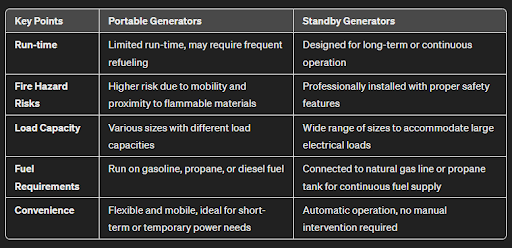As we brace ourselves for the upcoming hurricane season, the forecast from Colorado State University’s tropical meteorology project team serves as a stark reminder of the potential impact of these natural disasters. With 23 storms, 11 hurricanes, and five major hurricanes predicted, the need for preparedness has never been more critical. Among the myriad of considerations for businesses and commercial properties, ensuring uninterrupted power supply stands as a cornerstone of resilience.
Exploring Temporary Power Options
In the realm of temporary power solutions, two primary options stand out: portable and standby generators. Understanding their nuances is vital for selecting the most suitable option for commercial properties. Portable generators offer flexibility but come with limitations in terms of capacity and run-time, whereas standby generators provide robust, automatic backup power but require professional installation and maintenance.

Determining Generator Size Requirements
The age-old question of “What Size Generator Do I Need?” becomes a critical consideration for business continuity. Calculating power requirements tailored to the unique needs of your business is crucial for ensuring adequate backup power during outages. This involves assessing essential systems like IT infrastructure, manufacturing processes, and HVAC systems. For IT-dependent businesses, ensuring the uninterrupted flow of data requires careful consideration of server, networking, and storage system power demands. Similarly, in manufacturing environments, accounting for the power needs of assembly lines and machinery is essential to prevent costly downtime. Additionally, facilities reliant on climate control must factor in HVAC system requirements to maintain stable conditions. By conducting a thorough analysis and leveraging modern tools, businesses can confidently determine the right generator size to weather the storm and safeguard continuity.
Implementing a Comprehensive Power Contingency Plan
Preparedness shouldn’t be seasonal; it should be a year-round endeavor. A comprehensive power contingency plan encompasses generator maintenance, fuel management, testing protocols, and emergency response procedures.
Generators play a pivotal role in maintaining business continuity, underscoring the necessity of diligent planning and execution. Regular maintenance ensures that generators remain in optimal condition, ready to spring into action when needed most. Efficient fuel management guarantees a steady supply during extended outages, while rigorous testing protocols validate the reliability of backup systems. Moreover, well-defined emergency response procedures empower employees to respond swiftly and effectively in crisis situations, minimizing downtime and mitigating potential losses. By integrating these elements into a cohesive strategy, businesses can fortify their resilience against unforeseen disruptions and emerge stronger in the face of adversity.
Preparing for Hurricane Season
Before the storm clouds gather, it’s essential to review insurance policies and emergency plans. Collaborating with insurance agents to understand coverage for hurricane-related damages can alleviate financial burdens in the aftermath. Moreover, activating emergency plans at the first hint of a Hurricane Watch is imperative for swift response.
Additionally, verifying the readiness of backup power systems such as generators and uninterruptible power supplies (UPS) is non-negotiable. Ensuring fuel tanks are topped up and systems are operational through regular testing guarantees preparedness when the lights go out. Stockpiling emergency supplies and compiling a list of essential contacts further fortifies readiness.
Prioritizing Generator Safety
Generators are indispensable assets, providing crucial backup power during emergencies. Yet, their operation entails inherent risks that demand careful attention. Ensuring generator safety is key for safeguarding lives and protecting business-owned property. Proper installation by qualified professionals, routine maintenance schedules, and storage of fuel in well-ventilated areas mitigate hazards like carbon monoxide poisoning and fire outbreaks. Grounding generators, utilizing appropriate electrical safety measures, and educating employees on safety protocols further reduce risks. Carbon monoxide detectors, fire extinguishers, and regular training sessions bolster preparedness, emphasizing the importance of proactive safety measures. By prioritizing generator safety through comprehensive measures and employee empowerment, businesses can fortify their resilience against unforeseen outages and potential accidents, ensuring uninterrupted operations even in the face of adversity.
As we navigate the uncertainties of the upcoming hurricane season, understanding temporary power solutions emerges as a linchpin of resilience for commercial properties and businesses. Proactive measures, from reviewing insurance policies to implementing comprehensive contingency plans, can mitigate risks and safeguard operations against power disruptions. Let’s fortify our readiness and stand resilient in the face of adversity.
Take a proactive stance in assessing your current power preparedness and shore up any deficiencies in your contingency plans. For further insights and resources on temporary power solutions and hurricane preparedness, reach out to Watterson today. Together, let’s weather the storm and emerge stronger on the other side.


